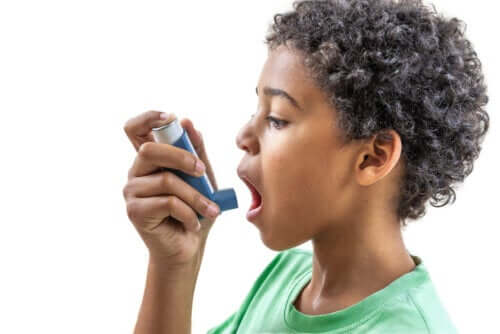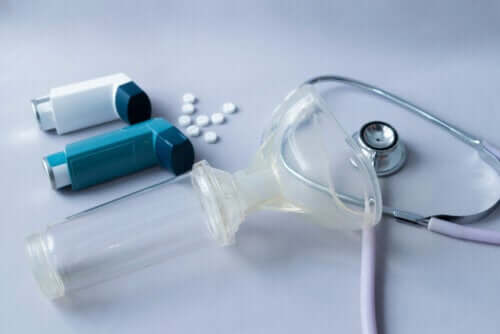The Use of Bronchodilators in Children


Written and verified by the pharmacist Sara Viruega Encinas
The use of bronchodilators is the treatment for many of the most frequent respiratory illnesses in childhood. They’re mainly useful in the management of asthma.
In this article, we’ll see what these drugs are, how they work, and how they should be used in children. First of all, in order to better understand the use of bronchodilators, it’s helpful to clarify how our respiratory system works.
The respiratory system
When we inhale, air enters our body through the nose or mouth and flows down the trachea. This duct branches into two bronchi that go on to each lung and which, in turn, divide into smaller and more numerous bronchioles and, finally, into alveoli.
It’s in the alveoli that the exchange of oxygen and carbon dioxide with our blood takes place. The small blood capillaries surrounding the alveoli take the oxygen from the air that we inhale and then send it to the heart. Then, the heart distributes it through the blood to the rest of the body.
In the same way, the blood deposits in the alveoli the carbon dioxide coming from the body, which we expel through the nose and mouth. The itinerary is the same, but the opposite.

The respiratory muscles of the thorax, such as the diaphragm, control the entire breathing process (inhalation-exhalation).
For example, in asthma, the airways become inflamed and accumulate mucus that complicates the passage of air. Something similar happens in bronchiolitis, as the bronchioles become inflamed and mucus accumulates, making breathing difficult. So, let’s see how bronchodilators can help in these cases.
What are bronchodilator drugs?
Bronchodilators are those drugs that open the bronchi. So, the use of bronchodilators allows air to pass through the airways properly. As their name indicates, they dilate the bronchi and bronchioles which, as we’ve said, are the structures that form the inside of the lungs and conduct the air. They usually come in the form of inhalers.
Bronchodilators can be classified into two main groups:
- Short-acting: They’re used in specific moments of crisis to facilitate breathing quickly. They take a short time to take effect, although this doesn’t last long. For example, a doctor may prescribe them for asthma attacks that result from physical exercise. Among them, we have:
- Albuterol: Always administered with a nebulizer
- Terbutaline: Used in older children
- Long-acting: Used to prevent and control symptoms in the longer term. They take longer to take effect but have a longer duration. They’re used in continuous maintenance treatments and always accompanied by inhaled corticosteroids, never alone. The most frequent combinations are:
- Salmeterol + Fluticasone
- Formoterol + Budesonide
Use of bronchodilators in children
One of the most commonly used bronchodilators in children is albuterol, better known by its brand name, Ventolin. This is a short-acting bronchodilator that belongs to the group of beta-2-adrenergic agonists. They go by this name because they act on a specific receptor in the smooth muscle of the lung.
What Ventolin does is relax the muscles in the walls of the airways, facilitating the passage of air. This reduces shortness of breath, as well as coughing and chest tightness, the common symptoms of an asthma attack.
Normally, individuals use short-acting bronchodilators, such as Ventolin, on demand, i.e. only when they need them. This is to prevent the rebound effect that can occur with continued use, making symptoms even worse. As side effects, palpitations and tachycardia may occur.
On the other hand, the use of bronchodilators in children with other illnesses, such as bronchiolitis, is controversial among professionals. According to the latest studies, bronchodilators have no proven efficacy in the treatment of bronchiolitis. In fact, they cause more side effects than clinical benefits.

How are bronchodilators used in children?
Bronchodilators in children are always administered by inhalation. For this purpose, a pressurized inhaler is used, which attaches to a spacer chamber to improve the efficiency of inhalation.
In infants and young children, a face mask covering the child’s mouth and nose attaches to the chamber. At the end of inhalation, if possible, it’s best to wash the mouth and the area of contact with the mask.
In the event of a severe crisis, or when the child also needs oxygen, the nebulization technique is an option. In this case, the patient takes the medication in liquid form together with a flow of oxygen, thus forming an aerosol.
This involves using a mask that attaches to a reservoir that contains the medication and to the oxygen source. Nebulizers are generally used in the hospital setting or in health centers.
The process shouldn’t take more than 15 minutes. It allows for the administration of more medication and to do so together with oxygen. However, they don’t really have many advantages over pressurized inhalers.
Respiratory illnesses in children and the use of bronchodilators
Bronchodilators in children are useful in the treatment of certain respiratory pathologies, such as asthma. You should never use them without a doctor’s prescription.
Before administering them, it’s important to learn how to handle them properly to ensure their effectiveness. Don’t hesitate to ask your pediatrician about any fears you may have, as they’ll know how to help you.
The use of bronchodilators is the treatment for many of the most frequent respiratory illnesses in childhood. They’re mainly useful in the management of asthma.
In this article, we’ll see what these drugs are, how they work, and how they should be used in children. First of all, in order to better understand the use of bronchodilators, it’s helpful to clarify how our respiratory system works.
The respiratory system
When we inhale, air enters our body through the nose or mouth and flows down the trachea. This duct branches into two bronchi that go on to each lung and which, in turn, divide into smaller and more numerous bronchioles and, finally, into alveoli.
It’s in the alveoli that the exchange of oxygen and carbon dioxide with our blood takes place. The small blood capillaries surrounding the alveoli take the oxygen from the air that we inhale and then send it to the heart. Then, the heart distributes it through the blood to the rest of the body.
In the same way, the blood deposits in the alveoli the carbon dioxide coming from the body, which we expel through the nose and mouth. The itinerary is the same, but the opposite.

The respiratory muscles of the thorax, such as the diaphragm, control the entire breathing process (inhalation-exhalation).
For example, in asthma, the airways become inflamed and accumulate mucus that complicates the passage of air. Something similar happens in bronchiolitis, as the bronchioles become inflamed and mucus accumulates, making breathing difficult. So, let’s see how bronchodilators can help in these cases.
What are bronchodilator drugs?
Bronchodilators are those drugs that open the bronchi. So, the use of bronchodilators allows air to pass through the airways properly. As their name indicates, they dilate the bronchi and bronchioles which, as we’ve said, are the structures that form the inside of the lungs and conduct the air. They usually come in the form of inhalers.
Bronchodilators can be classified into two main groups:
- Short-acting: They’re used in specific moments of crisis to facilitate breathing quickly. They take a short time to take effect, although this doesn’t last long. For example, a doctor may prescribe them for asthma attacks that result from physical exercise. Among them, we have:
- Albuterol: Always administered with a nebulizer
- Terbutaline: Used in older children
- Long-acting: Used to prevent and control symptoms in the longer term. They take longer to take effect but have a longer duration. They’re used in continuous maintenance treatments and always accompanied by inhaled corticosteroids, never alone. The most frequent combinations are:
- Salmeterol + Fluticasone
- Formoterol + Budesonide
Use of bronchodilators in children
One of the most commonly used bronchodilators in children is albuterol, better known by its brand name, Ventolin. This is a short-acting bronchodilator that belongs to the group of beta-2-adrenergic agonists. They go by this name because they act on a specific receptor in the smooth muscle of the lung.
What Ventolin does is relax the muscles in the walls of the airways, facilitating the passage of air. This reduces shortness of breath, as well as coughing and chest tightness, the common symptoms of an asthma attack.
Normally, individuals use short-acting bronchodilators, such as Ventolin, on demand, i.e. only when they need them. This is to prevent the rebound effect that can occur with continued use, making symptoms even worse. As side effects, palpitations and tachycardia may occur.
On the other hand, the use of bronchodilators in children with other illnesses, such as bronchiolitis, is controversial among professionals. According to the latest studies, bronchodilators have no proven efficacy in the treatment of bronchiolitis. In fact, they cause more side effects than clinical benefits.

How are bronchodilators used in children?
Bronchodilators in children are always administered by inhalation. For this purpose, a pressurized inhaler is used, which attaches to a spacer chamber to improve the efficiency of inhalation.
In infants and young children, a face mask covering the child’s mouth and nose attaches to the chamber. At the end of inhalation, if possible, it’s best to wash the mouth and the area of contact with the mask.
In the event of a severe crisis, or when the child also needs oxygen, the nebulization technique is an option. In this case, the patient takes the medication in liquid form together with a flow of oxygen, thus forming an aerosol.
This involves using a mask that attaches to a reservoir that contains the medication and to the oxygen source. Nebulizers are generally used in the hospital setting or in health centers.
The process shouldn’t take more than 15 minutes. It allows for the administration of more medication and to do so together with oxygen. However, they don’t really have many advantages over pressurized inhalers.
Respiratory illnesses in children and the use of bronchodilators
Bronchodilators in children are useful in the treatment of certain respiratory pathologies, such as asthma. You should never use them without a doctor’s prescription.
Before administering them, it’s important to learn how to handle them properly to ensure their effectiveness. Don’t hesitate to ask your pediatrician about any fears you may have, as they’ll know how to help you.
All cited sources were thoroughly reviewed by our team to ensure their quality, reliability, currency, and validity. The bibliography of this article was considered reliable and of academic or scientific accuracy.
- Úbeda Sansano, M. I., Cortés Rico, O., Montón Alvarez, J. L., Lora Espinosa, A., & Praena Crespo, M. (2013). Dispositivos de inhalación. El Pediatra de Atención Primaria y los dispositivos de inhalación. Documentos técnicos del GVR.
- García Merino, A. (2015). Esteller Carceller M. Terapia inhalada: lo que nos queda por saber. AEPap (ed.). Curso de Actualización Pediatría, 347-61.
- Gadomski, A. M., & Scribani, M. B. (2014). Bronchodilators for bronchiolitis. Cochrane database of systematic reviews, (6).
This text is provided for informational purposes only and does not replace consultation with a professional. If in doubt, consult your specialist.








